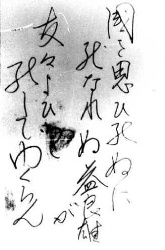 W
WThe death poem is a genre of poetry that developed in the literary traditions of East Asian cultures—most prominently in Japan as well as certain periods of Chinese history and Joseon Korea. They tend to offer a reflection on death—both in general and concerning the imminent death of the author—that is often coupled with a meaningful observation on life. The practice of writing a death poem has its origins in Zen Buddhism. It is a concept or worldview derived from the Buddhist teaching of the three marks of existence , specifically that the material world is transient and impermanent , that attachment to it causes suffering , and ultimately all reality is an emptiness or absence of self-nature . These poems became associated with the literate, spiritual, and ruling segments of society, as they were customarily composed by a poet, warrior, nobleman, or Buddhist monk.
 W
WJunshi refers to the medieval Japanese act of vassals committing seppuku for the death of their lord. Originally it was only performed when the lord was slain in battle or murdered.
 W
WSeppuku , sometimes referred to as harakiri, is a form of Japanese ritual suicide by disembowelment. It was originally reserved for samurai in their code of honor but was also practiced by other Japanese people during the Shōwa period to restore honor for themselves or for their families. As a samurai practice, seppuku was used voluntarily by samurai to die with honor rather than fall into the hands of their enemies, as a form of capital punishment for samurai who had committed serious offenses, or performed because they had brought shame to themselves. The ceremonial disembowelment, which is usually part of a more elaborate ritual and performed in front of spectators, consists of plunging a short blade, traditionally a tantō, into the belly and drawing the blade from left to right, slicing the belly open. If the cut is deep enough, it can sever the abdominal aorta, causing a rapid death by blood loss.
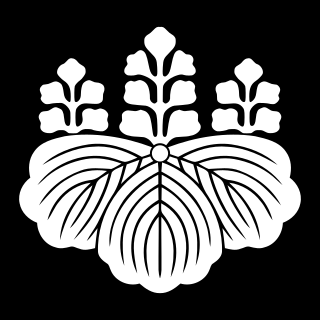 W
WAkamatsu Mitsusuke was a Japanese samurai of the Akamatsu clan during the Sengoku Period.
 W
WAmago Katsuhisa was a remnant of the Amago clan, a powerful feudal clan in the Chūgoku region of Japan, backed up by Yamanaka Yukimori, a vassal of the clan.
 W
WAsakura Yoshikage was a Japanese daimyō of the Sengoku period (1467–1603) who ruled a part of Echizen Province in present-day Fukui Prefecture. Yoshikage's conflicts with Oda Nobunaga (1534–1582) resulted in his death and the destruction of the Asakura clan and its castle, Ichijōdani Castle.
 W
WAsano Naganori was the daimyō of the Akō Domain in Japan (1675–1701). His title was Takumi no Kami (内匠頭). He is known as the person who triggered a series of incidents retold in a story known as Chūshingura, one of the favourite themes of kabuki, jōruri, and Japanese books and films.
 W
WAtagi Fuyuyasu , third son of Miyoshi Motonaga, brothers of Miyoshi Nagayoshi, Miyoshi Yukiyasu and Sogō Kazunari, was a Japanese samurai who lived in the Sengoku period. He was active in the Awaji region, and was also known as a poet. He had a son named Atagi Nobuyasu. He was also known as Waka poet.
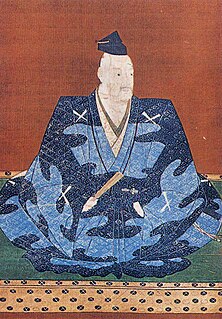 W
WAzai Hisamasa was a son of Azai Sukemasa and the second head of the Azai clan.
 W
WAzai Nagamasa was a Japanese daimyō of the Sengoku period known as the brother-in-law and enemy of Oda Nobunaga. Nagamasa was head of the Azai clan seated at Odani Castle in northern Ōmi Province and married Nobunaga's sister Oichi in 1564, fathering her three daughters – Yodo-dono, Ohatsu, and Oeyo – who became prominent figures in their own right.
 W
WBessho Nagaharu was a Japanese daimyō of the Sengoku period. He was the eldest son of Bessho Yasuharu.
 W
WThe revenge of the forty-seven rōnin , also known as the Akō incident or Akō vendetta, is a historical 18th-century event in Japan in which a band of rōnin avenged the death of their master. The incident has since become legendary. It is one of the three major adauchi vendetta incidents in Japan, alongside the Revenge of the Soga Brothers and the Igagoe vendetta.
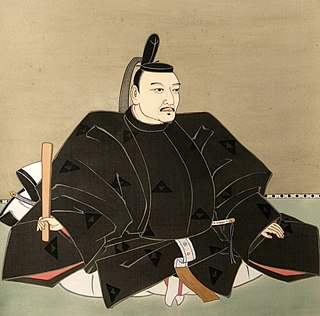 W
WHōjō Ujimasa was the fourth head of the later Hōjō clan, and daimyō of Odawara. His childhood name was Matsuchiyo-maru (松千代丸). He was a son-in-law of Takeda Shingen. In 1560, Hojo clan seized Iwatsuki Castle and almost conquered whole Musashi Province. Ujimasa commanded in many battles, including the Siege of Odawara (1569) and the Battle of Omosu (1580).
 W
WHōjō Ujiteru (1540? – August 10, 1590) was a Japanese samurai, who was the son of Hōjō Ujiyasu and lord of Hachiōji Castle in what is now Tokyo.
 W
WA kaishakunin is a person appointed to behead an individual who has performed seppuku, Japanese ritual suicide, at the moment of agony. The role played by the kaishakunin is called kaishaku.
 W
WMaki Yasuomi was a Japanese samurai of the late Edo period, who served as a retainer of the Arima clan of Kurume in northern Kyūshū. He was also a Shinto priest of the Suitengū shrine in Kurume. Maki, also known by his court title of Maki Izumi no kami (真木和泉守) or simply Maki Izumi , was a student of the Mito school's sonnō-jōi ideology, and in particular, Aizawa Seishisai's philosophy.
 W
WMatsudaira Nobuyasu was the eldest son of Tokugawa Ieyasu. His tsūshō was Jirōsaburō (次郎三郎). He was called also "Okazaki Saburō" , because he had become the lord of Okazaki Castle (岡崎城) in 1570. Because he was a son of Tokugawa Ieyasu, he is often referred to, retroactively, as Tokugawa Nobuyasu .
 W
WMinamoto no Tametomo , also known as Chinzei Hachirō Tametomo , was a samurai who fought in the Hōgen Rebellion of 1156. He was the son of Minamoto no Tameyoshi, and brother to Yukiie and Yoshitomo.
 W
WMinamoto no Yorimasa was a prominent Japanese poet whose works appeared in various anthologies. He served eight different emperors in his long career, holding posts such as hyōgo no kami. He was also a warrior, leading the Minamoto armies at the beginning of the Genpei War.
 W
WMinamoto no Yoshitsune was a military commander of the Minamoto clan of Japan in the late Heian and early Kamakura periods. During the Genpei War, he led a series of battles which toppled the Ise-Heishi branch of the Taira clan, helping his half-brother Yoritomo consolidate power. He is considered one of the greatest and the most popular warriors of his era, and one of the most famous samurai fighters in the history of Japan. Yoshitsune perished after being betrayed by the son of a trusted ally.
 W
WMori Ranmaru , also known as Mori Naritoshi, was the son of Mori Yoshinari, and had 5 brothers in total, from the province of Mino. He was a member of the Mori Clan, descendants of the Seiwa Genji.
 W
WMurakami Domain was a feudal domain under the Tokugawa shogunate of Edo period Japan, located in Echigo Province, Japan. It was centered on Murakami Castle in what is now the city of Murakami, Niigata.
 W
WOda Nobunaga was a Japanese daimyo and one of the leading figures of the Sengoku period. He is regarded as the first "Great Unifier" of Japan. His reputation in war gave him the nickname of "Demon King".
 W
WOda Nobutada was a samurai and the eldest son of Oda Nobunaga, who fought in many battles during the Sengoku period of Japan. He commanded armies under his father in battles against Matsunaga Hisahide and against the Takeda clan.
 W
WOda Nobutaka was a samurai and member of the Oda clan. He was adopted as the head of the Kanbe clan, which ruled the middle region of Ise Province and so he was also called Kanbe Nobutaka (神戸信孝).
 W
WŌhara Yūgaku was a 19th-century Japanese agronomist, philosopher, moralist and economist. Contemporary with the more famous Ninomiya Sontoku, he combined three strands of traditional teachings — Buddhism, Shintōism and Confucianism into practical ethical principles which he applied to form an agricultural cooperative in 1838.
 W
WŌishi Yoshio was the chamberlain (karō) of the Akō Domain in Harima Province, Japan. He is known as the leader of the Forty-seven Rōnin in their 1702 revenge vendetta and thus the hero of the Chūshingura. He is often referred to by his title, Ōishi Kuranosuke (大石内蔵助).
 W
WŌtani Yoshitsugu was a Japanese samurai of the Sengoku period through the Azuchi-Momoyama Period. He was also known by his court title, Gyōbu-shōyū (刑部少輔). He was born in 1558 to a father who was said to be a retainer of either Ōtomo Sōrin or Rokkaku Yoshikata. He became one of Toyotomi Hideyoshi's followers. He participated in the Toyotomi's Odawara campaign and Korean campaign.
 W
WŌuchi Yoshitaka was the daimyō of Suō Province and the head of the Ōuchi clan, succeeding Ōuchi Yoshioki.
 W
WSassa Narimasa , also known as Kura-no-suke (内蔵助), was a Japanese samurai of the Sengoku through Azuchi–Momoyama period. He entered Nobunaga's service at the age of 14 and remained in his lord's service throughout Nobunaga's rise to power.
 W
WSen no Rikyū , also known simply as Rikyū, is considered the historical figure with the most profound influence on chanoyu, the Japanese "Way of Tea", particularly the tradition of wabi-cha. He was also the first to emphasize several key aspects of the ceremony, including rustic simplicity, directness of approach and honesty of self. Originating from the Sengoku period and the Azuchi–Momoyama period, these aspects of the tea ceremony persist. Rikyū is known by many names; for consistency, he will be referred to as Rikyū in this article.
 W
WShibata Katsuie or Gonroku (権六) was a Japanese samurai and military commander during the Sengoku period. He served Oda Nobunaga as one of his trusted generals, was severely wounded in the 1571 siege of Nagashima, but then fought in the 1577 Battle of Tedorigawa.
 W
WShimizu Muneharu , also known as Shimizu Chōzaemon , was a military commander during the Sengoku period. He served the Mōri clan as a retainer to Kobayakawa Takakage and took part in the expedition to unify the Chūgoku region. He was lord of Shimizu castle at Bitchu Province, and became the lord of the Bitchu Takamatsu Castle after he captured it in 1565. His father was Shimizu Munenori.
 W
WPrince Takanaga was the second son of Emperor Go-Daigo of Japan. He fought for his father in the Nanboku-chō Wars. Since the characters used to write "Takanaga" can also be read as "Takayoshi", the prince is sometimes known by that name as well.
 W
WTakebayashi Takashige was a Samurai in the early Edo period of Japan. He was involved in the revenge of the Forty-seven rōnin incident as one of the rōnin. Takashige was originally a subordinate of the daimyō Asano Naganori, master of Akō Domain.
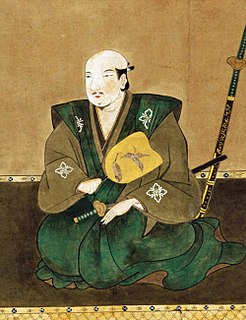 W
WTakeda Katsuyori was a Japanese daimyō of the Sengoku period, who was famed as the head of the Takeda clan and the successor to the legendary warlord Takeda Shingen.
 W
WTokugawa Tadanaga was a Japanese daimyō of the early Edo period. The son of the second shōgun Tokugawa Hidetada, his elder brother was the third shōgun Tokugawa Iemitsu.
 W
WTorii Mototada was a Japanese Samurai and Daimyo of the Sengoku period through late Azuchi–Momoyama period, who served Tokugawa Ieyasu. Torii died at the siege of Fushimi where his garrison was greatly outnumbered and destroyed by the army of Ishida Mitsunari. Torii's refusal to surrender had a great impact on Japanese history; the fall of Fushimi bought Ieyasu some time to regroup and eventually win the Battle at Sekigahara.
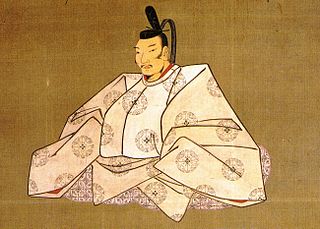 W
WToyotomi Hidetsugu was a daimyō during the Sengoku period of Japan. He was the nephew and retainer of Toyotomi Hideyoshi, the unifier and ruler of Japan from 1590 to 1598. Despite being Hideyoshi's closest adult, male relative, Hidetsugu was accused of atrocities and attempting to stage a coup after the birth of Hideyoshi's son, and he was ordered to commit suicide. Hidetsugu's entire family, including children, were also executed on Hideyoshi's orders. His death and that of his family contributed to the quick dissolution of Toyotomi authority after Hideyoshi's death three years later.
 W
WToyotomi Hideyori was the son and designated successor of Toyotomi Hideyoshi, the general who first united all of Japan. His mother, Yodo-dono, was the niece of Oda Nobunaga.
 W
WWatanabe Kazan was a Japanese painter, scholar and statesman member of the samurai class.